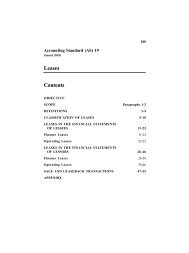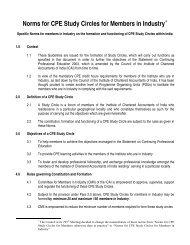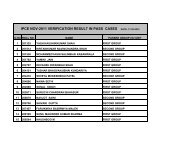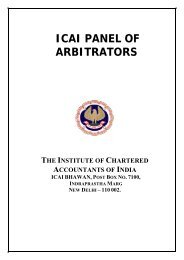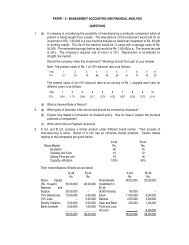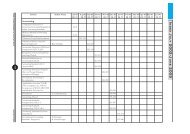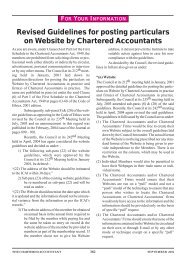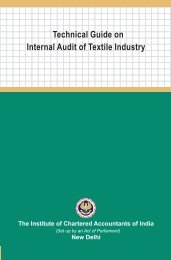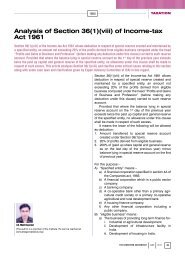The Chartered Accountant
The Chartered Accountant
The Chartered Accountant
Create successful ePaper yourself
Turn your PDF publications into a flip-book with our unique Google optimized e-Paper software.
Some loans may be interest-free or<br />
require that only a portion of the<br />
actual interest cost be recovered and<br />
grants or capital injections do not<br />
normally incur interest. Borrowing<br />
costs in respect of such borrowings<br />
do not qualify for capitalisation.<br />
18. To the extent that an entity<br />
borrows funds specifically for the<br />
purpose of acquiring, constructing<br />
or producing a qualifying asset,<br />
the entity should determine<br />
the amount of borrowing costs eligible<br />
for capitalisation as the actual<br />
borrowing costs incurred on<br />
that borrowing during the period<br />
less any income on the temporary<br />
investment of those borrowings.<br />
19. <strong>The</strong> financing arrangements for a<br />
qualifying asset may result in an entity<br />
obtaining borrowed funds and<br />
incurring associated borrowing costs<br />
before some or all of the funds are<br />
used for expenditures on the qualifying<br />
asset. In such circumstances, the<br />
funds are often temporarily invested<br />
pending their expenditures on the<br />
qualifying asset. In determining the<br />
amount of borrowing costs eligible<br />
for capitalisation during a period, any<br />
income earned on temporary investment<br />
of such funds is deducted from<br />
the borrowing costs incurred.<br />
20. If a controlling entity borrows<br />
funds which are then loaned to a<br />
controlled entity, the controlled entity<br />
may captalise only those borrowing<br />
costs which it itself incurs specifically<br />
in relation to the acquisition, construction<br />
or production of a qualifying<br />
asset. Such costs will normally be<br />
documented in loan agreement with<br />
the controlling entity. Where a controlled<br />
entity receives an interest-free<br />
capital contribution or capital grant,<br />
it will not incur any borrowing costs<br />
and consequently will not capitalise<br />
any such costs.<br />
21. When a controlling entity trans-<br />
DECEMBER 2008 1082THE<br />
CHARTERED ACCOUNTANT<br />
STANDARDS<br />
fers funds at partial cost to a controlled<br />
entity, the controlled entity<br />
may capitalise that portion of borrowing<br />
costs which it itself has incurred<br />
specifically for the acquisition,<br />
construction or production of<br />
a qualifying asset. <strong>The</strong>se borrowing<br />
costs are not necessarily identical to<br />
the borrowing costs incurred by the<br />
controlling entity. In the financial<br />
statements of the economic entity,<br />
the full amount of borrowing costs<br />
specifically incurred for the acquisition,<br />
construction or production of<br />
a qualifying asset can be capitalised<br />
as part of the cost of that qualifying<br />
asset, provided that appropriate<br />
consolidation adjustments have been<br />
made to eliminate those costs capitalised<br />
by the controlled entity.<br />
22. When a controlling entity has<br />
transferred funds at no cost to a controlled<br />
entity, neither the controlling<br />
entity nor the controlled entity would<br />
meet the criteria for capitalisation of<br />
borrowing costs in their separate financial<br />
statements. However, if the<br />
economic entity met the criteria for<br />
capitalisation of borrowing costs, it<br />
would be able to capitalise the borrowing<br />
costs to the qualifying asset in<br />
its financial statements.<br />
23. When a controlling entity borrows<br />
funds generally, and lends part<br />
of those funds to a controlled entity<br />
specifically for the acquisition, construction<br />
or production of a qualifying<br />
asset, the borrowing costs of<br />
the controlling entity are not eligible<br />
for capitalisation either by that controlling<br />
entity in its separate financial<br />
statements or by the economic<br />
entity in its consolidated financial<br />
statements. <strong>The</strong> borrowing costs of<br />
the controlled entity may, however,<br />
be eligible for capitalisation in the<br />
controlled entity’s separate financial<br />
statements. If the controlling entity<br />
borrows funds specifically for the<br />
acquisition, construction or produc-<br />
tion of a qualifying asset by a controlled<br />
entity, those borrowing costs,<br />
if transferred to the controlled entity,<br />
are capitalised in the separate financial<br />
statements of the controlled entity<br />
and in the consolidated financial<br />
statements of the economic entity.<br />
Excess of the Carrying Am-<br />
ount of the Qualifying Asset<br />
over Recoverable Amount<br />
24. When the carrying amount or the<br />
expected ultimate cost of the qualifying<br />
asset exceeds its recoverable<br />
amount or net realisable value, the<br />
carrying amount is written down or<br />
written off in accordance with the<br />
requirements of other Accounting<br />
Standards for Local Bodies. In certain<br />
circumstances, the amount of<br />
the write-down or write-off is written<br />
back in accordance with those<br />
Accounting Standards.<br />
Commencement of Capitalisation<br />
25. <strong>The</strong> capitalisation of borrowing<br />
costs as part of the cost of a<br />
qualifying asset should commence<br />
when all the following conditions<br />
are satisfied:<br />
(a) expenditure for the acquisition,<br />
construction or production<br />
of qualifying asset<br />
is being incurred;<br />
(b) borrowing costs are being<br />
incurred specifically for the<br />
acquisition, construction<br />
or production of a qualifying<br />
asset; and<br />
(c) activities that are necessary<br />
to prepare the asset for its<br />
intended use or sale are in<br />
progress.<br />
26. Expenditures on a qualifying asset<br />
include only such expenditures<br />
that have resulted in payments of<br />
cash, transfers of other assets or the<br />
assumption of interest bearing liabil-



